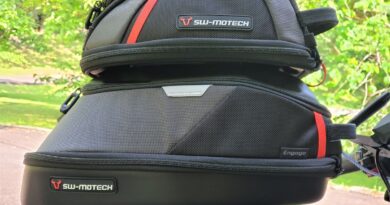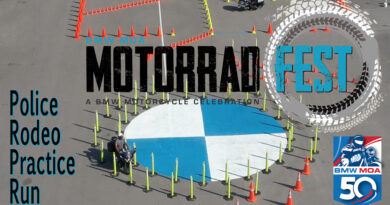Keeping Your Cool, Part 3: Upper Body
Previously in this series, we discussed the basics of hot-weather motorcycling, the critical importance of keeping our brains from overheating and the outsized effectiveness of evaporative cooling neck wraps. Here’s a truly special piece of gear to involve your upper body in the heat-management process, maximizing comfort and safety at the same time.
LDComfort Long-sleeved Mock Turtle Neck Shirt
Those initials stand for “Long Distance,” but it’d be equally fitting if they denoted “Large Degrees.” While a much clumsier acronym, the latter calls attention to a primary function of this line of base layers: management of high temperatures. When you think about what shirt to wear in hot weather, a black, long-sleeved, tall-collared choice is probably the one you’d most vehemently denounce, and you’d be absolutely right if you were talking about normal everyday use. However, if discussing motorcycling in moderate to extreme heat, one such option is exceptionally appropriate. We’ll assume you’re an ATGATT subscriber, so a jacket will be shielding your torso from the sun’s radiant energy, thereby rendering the color of your shirt irrelevant (no absorption of heat by the dark color). Given the power of this shirt’s fabric to cool the skin beneath it, you’ll want as much contact as possible, hence the utility of arm and neck coverage. This cooling prowess is achieved with a unique dual-layer fabric, and its thin-yet-plush material provides a silky, cushy buffer against chaffing between skin and jacket sleeves and collars—so much to love!
 LDComfort’s product lineup (including a variety of other garments) utilizes a special multi-component material they call Dryline. Although it looks and feels like a single layer, it’s actually comprised of an interwoven pair—an inner made of hydrophobic (water-rejecting) polyester and an outer made of hydrophilic (water-retaining) nylon. Both layers also incorporate some Lycra for resilient elasticity in every direction, maintaining a snug yet non-restrictive fit. The interior layer absorbs moisture from the skin, just like “wicking” outerwear, but instead of that moisture being quickly discharged into the atmosphere (as might happen while wearing a nylon shirt without any gear covering it), the moisture is immediately absorbed by the exterior nylon layer. The resulting transport leaves the inner surface of the shirt feeling incredibly dry against the skin, even when the outer surface is quite wet—an uncanny contrast.
LDComfort’s product lineup (including a variety of other garments) utilizes a special multi-component material they call Dryline. Although it looks and feels like a single layer, it’s actually comprised of an interwoven pair—an inner made of hydrophobic (water-rejecting) polyester and an outer made of hydrophilic (water-retaining) nylon. Both layers also incorporate some Lycra for resilient elasticity in every direction, maintaining a snug yet non-restrictive fit. The interior layer absorbs moisture from the skin, just like “wicking” outerwear, but instead of that moisture being quickly discharged into the atmosphere (as might happen while wearing a nylon shirt without any gear covering it), the moisture is immediately absorbed by the exterior nylon layer. The resulting transport leaves the inner surface of the shirt feeling incredibly dry against the skin, even when the outer surface is quite wet—an uncanny contrast.
Aside from the hot-weather advantages that follow, note that dry skin is a big plus in cold weather, too. Single-ply polypropylene, polyester, or nylon may wick perspiration into the fabric, but then what? If the fabric can’t release that moisture into the air because of other layers of clothing, you still have damp, clingy cloth in contact with your body, an unpleasant sensation and potentially a source of skin irritation. Dry skin feels cooler in the heat and warmer in the cold, especially when either temperature range is accompanied by high humidity. Needless to say, wearing anything between your skin and Dryline defeats its purpose.
This dichotomy between inner and outer moisture levels is really put to best use by deliberately soaking the shirt prior to wearing it in hot weather. Note that pouring water on a dry shirt will result in much of it just running off. It’s best to immerse the shirt or bunch it up to create pockets where the water can collect as you work it into the fabric. Once moistened, it’s quick to soak up additional fluid. The inside doesn’t feel wet at all (so weird!), but all that water held by the outside layer is released in a slow, controlled manner, delivering outstanding evaporative cooling. The effect is so powerful, Mario Winkleman, the motorcycling founder of LDComfort, claims it can yield as much as a 30° difference between the microclimate inside a jacket and the temperature of the exterior environment; he testifies to riding in reasonable comfort across desert landscapes in 120° heat. However, he also emphasizes the importance of restricting airflow through the jacket, closing all vents and opening only the sleeve cuffs, so that air forced in there moves up through the sleeves and then throughout the semi-sealed chamber formed around the torso before exiting at the collar. Such a system assumes non-mesh jacket construction and a loose fit that allows air to move freely within it, essentially mimicking the interior of an air-conditioned car with its windows up.
Although I had no way of objectively measuring the temperature of the interior microclimate created by my LDComfort shirt, here’s what I experienced. First, the methods LDComfort doesn’t recommend: Just out of curiosity, I tried the shirt fully soaked on a mild 75-degree summer morning in a mesh jacket; this setup was immediately too chilly! When wearing the shirt dry under a mesh jacket, I found it quite pleasant from 65° into the lower 80s. The fabric offered enough insulation at the low end of that range, and enough wicking/breathability to still be comfortable at the upper end. Once temps reached the upper 80s and low 90s, I could conveniently wet the shirt with a spray bottle of water from my tail pack in a few minutes by the side of the road. This could be partially accomplished without even taking off my jacket (the spray easily passed through the mesh panels), but a more thorough job required the jacket’s removal—it was simply a matter of how much cooling I wanted and how much time I chose to devote. In any case, the shirt supplied ample temperature reduction from 30-60 minutes, depending on how well I’d saturated it; I felt marvelously cool while chuckling at the incongruously high numbers on my dash’s temperature gauge. From the mid-90s into the low 100s, the mesh jacket allowed the shirt to dry out too quickly, even in very humid conditions. It still delivered the same cooling effect, but for only 20-30 minutes.
 After switching to non-mesh jackets, riding in the vicinity of 100° was rendered shockingly comfortable for 90-120 minutes. However, most of my jackets fit too snugly through the sleeves to use Mr. Winkleman’s method, and I had to resort to opening at least some of my vents. The shirt worked best when I could facilitate airflow over my arms, either via the sleeves’ cuffs or venting, no doubt a function of the fact lots more blood circulates along the surface of those limbs than near the surface of my torso. As the cooled blood traveled back from my arms into my core, it delivered a cooling benefit in addition to what I could feel directly around my chest, back and belly. Winkleman places primary emphasis on the arms by rewetting his shirt with an inverted squirt (not spray) bottle directed down the sleeve of each upstretched arm, a technique he can manage one-handed without leaving the saddle. I gave it a shot (literally), albeit off the bike, and found the influx of water down my arms, armpits, and sides bracing, almost like jumping into a cold pool on a hot day (the liquid initially saturates both layers of the fabric before the outer layer pulls it from the inner). However, while I easily appreciate the importance of keeping the shirt’s sleeves “charged” with water, I preferred stopping to wet the whole shirt with my spray bottle to achieve a more evenly distributed effect. After all, I wasn’t racing against the clock in an Iron Butt event. Also, the Winkleman technique ensures some water will travel further down into your pants. Unless you’re wearing the LDComfort shorts described in Part Four, this will not end well (pun intended).
After switching to non-mesh jackets, riding in the vicinity of 100° was rendered shockingly comfortable for 90-120 minutes. However, most of my jackets fit too snugly through the sleeves to use Mr. Winkleman’s method, and I had to resort to opening at least some of my vents. The shirt worked best when I could facilitate airflow over my arms, either via the sleeves’ cuffs or venting, no doubt a function of the fact lots more blood circulates along the surface of those limbs than near the surface of my torso. As the cooled blood traveled back from my arms into my core, it delivered a cooling benefit in addition to what I could feel directly around my chest, back and belly. Winkleman places primary emphasis on the arms by rewetting his shirt with an inverted squirt (not spray) bottle directed down the sleeve of each upstretched arm, a technique he can manage one-handed without leaving the saddle. I gave it a shot (literally), albeit off the bike, and found the influx of water down my arms, armpits, and sides bracing, almost like jumping into a cold pool on a hot day (the liquid initially saturates both layers of the fabric before the outer layer pulls it from the inner). However, while I easily appreciate the importance of keeping the shirt’s sleeves “charged” with water, I preferred stopping to wet the whole shirt with my spray bottle to achieve a more evenly distributed effect. After all, I wasn’t racing against the clock in an Iron Butt event. Also, the Winkleman technique ensures some water will travel further down into your pants. Unless you’re wearing the LDComfort shorts described in Part Four, this will not end well (pun intended).
While it’s a major advantage for the shirt’s absorbent layer to relinquish moisture slowly on a ride, you wouldn’t want it to take forever to dry after washing it (use mild soapy water) on a trip. I found the fabric completely dry after squeezing out as much water as possible by hand and then simply draping it over a towel rack or chairback overnight. This process can be accelerated by wrapping the shirt in a towel after the initial squeezing, as the terrycloth will keep small amounts of expressed water from being drawn back into the fabric between subsequent squeezes. An anti-microbial treatment helps prevent odors, even if nightly washing isn’t possible. If your riding day is hot in the middle and cool at both ends, you can leave in the morning with the shirt dry, wet it during the heat of the day, and simply stop re-wetting it as the temperature falls—all-day comfort with no change of clothes! Depending on the construction of your jacket, you could conceivably manage temps between 50 and 100 degrees with no more than vent adjustments and a bottle of water.
Compared to cooling vests (either stand-alone or detachable jacket liners) which also feature a dry inner layer and a wettable outer layer, the LD Comfort shirt is dramatically more effective due to its critically important cooling of the arms and continued wicking and breathability when its water supply has evaporated; cooling vests supply none of that. However, a cooling vest might be preferable in several situations: A) if you definitely don’t want any water running/seeping into your pants, B) if you are going to be in and out of settings wherein you want to be completely free of your riding gear without changing shirts, or C) if you want the vest as an additional layer of warmth/wind-blocking during days with more cold hours than hot ones.
Other LD Comfort shirts using the same Dryline fabric include a quarter-zipped version of this model, a crew-neck short-sleeved tee, a short-sleeved mock turtleneck, and “power temp cool sleeves” which are just what you’d expect: a pair of sleeves with no shirt. Long-sleeved models are available in men’s and women’s versions; the others are unisex. Note that because a snug fit is required for optimal effectiveness, LD Comfort has carefully developed a sizing chart using your actual waist and chest measurements, with sizes broken down into smaller-than-usual increments ranging from XS to 4XL. There are also “Lite” versions of some models for those who prefer an even thinner fabric, along with a sleeveless “combo” women’s top. All come in black, with a few exceptions offered in white or other colors. The shirt tested is priced at $82; the others range from $64-92. These are extraordinary values for anyone riding in temps above 85°, and worthwhile for riders in any climate.



